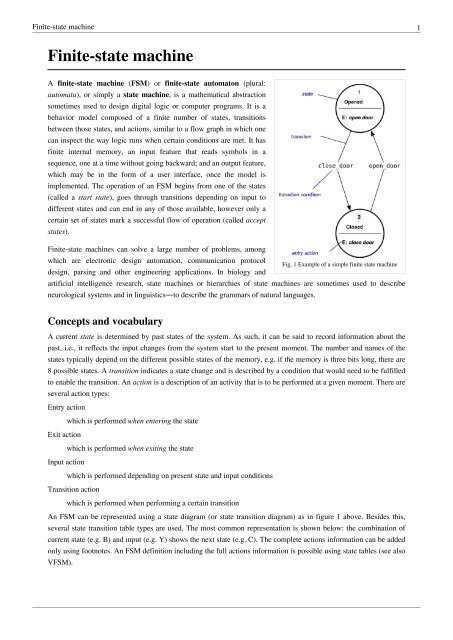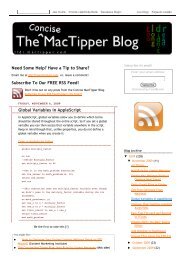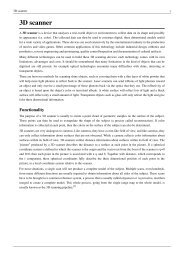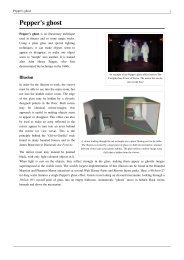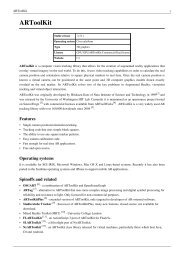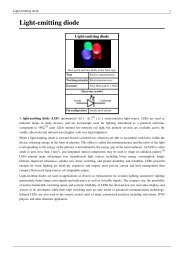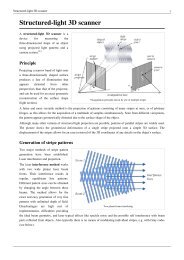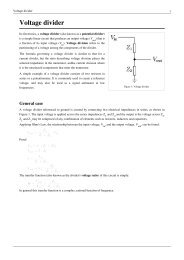Finite-state machine - Wikipedia, the free encyclopedia ... - Ex-ch.com
Finite-state machine - Wikipedia, the free encyclopedia ... - Ex-ch.com
Finite-state machine - Wikipedia, the free encyclopedia ... - Ex-ch.com
Create successful ePaper yourself
Turn your PDF publications into a flip-book with our unique Google optimized e-Paper software.
<strong>Finite</strong>-<strong>state</strong> <strong>ma<strong>ch</strong>ine</strong> 1<br />
<strong>Finite</strong>-<strong>state</strong> <strong>ma<strong>ch</strong>ine</strong><br />
A finite-<strong>state</strong> <strong>ma<strong>ch</strong>ine</strong> (FSM) or finite-<strong>state</strong> automaton (plural:<br />
automata), or simply a <strong>state</strong> <strong>ma<strong>ch</strong>ine</strong>, is a ma<strong>the</strong>matical abstraction<br />
sometimes used to design digital logic or <strong>com</strong>puter programs. It is a<br />
behavior model <strong>com</strong>posed of a finite number of <strong>state</strong>s, transitions<br />
between those <strong>state</strong>s, and actions, similar to a flow graph in whi<strong>ch</strong> one<br />
can inspect <strong>the</strong> way logic runs when certain conditions are met. It has<br />
finite internal memory, an input feature that reads symbols in a<br />
sequence, one at a time without going backward; and an output feature,<br />
whi<strong>ch</strong> may be in <strong>the</strong> form of a user interface, once <strong>the</strong> model is<br />
implemented. The operation of an FSM begins from one of <strong>the</strong> <strong>state</strong>s<br />
(called a start <strong>state</strong>), goes through transitions depending on input to<br />
different <strong>state</strong>s and can end in any of those available, however only a<br />
certain set of <strong>state</strong>s mark a successful flow of operation (called accept<br />
<strong>state</strong>s).<br />
<strong>Finite</strong>-<strong>state</strong> <strong>ma<strong>ch</strong>ine</strong>s can solve a large number of problems, among<br />
whi<strong>ch</strong> are electronic design automation, <strong>com</strong>munication protocol<br />
design, parsing and o<strong>the</strong>r engineering applications. In biology and<br />
Fig. 1 <strong>Ex</strong>ample of a simple finite <strong>state</strong> <strong>ma<strong>ch</strong>ine</strong><br />
artificial intelligence resear<strong>ch</strong>, <strong>state</strong> <strong>ma<strong>ch</strong>ine</strong>s or hierar<strong>ch</strong>ies of <strong>state</strong> <strong>ma<strong>ch</strong>ine</strong>s are sometimes used to describe<br />
neurological systems and in linguistics—to describe <strong>the</strong> grammars of natural languages.<br />
Concepts and vocabulary<br />
A current <strong>state</strong> is determined by past <strong>state</strong>s of <strong>the</strong> system. As su<strong>ch</strong>, it can be said to record information about <strong>the</strong><br />
past, i.e., it reflects <strong>the</strong> input <strong>ch</strong>anges from <strong>the</strong> system start to <strong>the</strong> present moment. The number and names of <strong>the</strong><br />
<strong>state</strong>s typically depend on <strong>the</strong> different possible <strong>state</strong>s of <strong>the</strong> memory, e.g. if <strong>the</strong> memory is three bits long, <strong>the</strong>re are<br />
8 possible <strong>state</strong>s. A transition indicates a <strong>state</strong> <strong>ch</strong>ange and is described by a condition that would need to be fulfilled<br />
to enable <strong>the</strong> transition. An action is a description of an activity that is to be performed at a given moment. There are<br />
several action types:<br />
Entry action<br />
<strong>Ex</strong>it action<br />
Input action<br />
whi<strong>ch</strong> is performed when entering <strong>the</strong> <strong>state</strong><br />
whi<strong>ch</strong> is performed when exiting <strong>the</strong> <strong>state</strong><br />
whi<strong>ch</strong> is performed depending on present <strong>state</strong> and input conditions<br />
Transition action<br />
whi<strong>ch</strong> is performed when performing a certain transition<br />
An FSM can be represented using a <strong>state</strong> diagram (or <strong>state</strong> transition diagram) as in figure 1 above. Besides this,<br />
several <strong>state</strong> transition table types are used. The most <strong>com</strong>mon representation is shown below: <strong>the</strong> <strong>com</strong>bination of<br />
current <strong>state</strong> (e.g. B) and input (e.g. Y) shows <strong>the</strong> next <strong>state</strong> (e.g. C). The <strong>com</strong>plete actions information can be added<br />
only using footnotes. An FSM definition including <strong>the</strong> full actions information is possible using <strong>state</strong> tables (see also<br />
VFSM).
<strong>Finite</strong>-<strong>state</strong> <strong>ma<strong>ch</strong>ine</strong> 2<br />
State transition table<br />
Current<br />
<strong>state</strong> →<br />
Input ↓<br />
State A State B State C<br />
Input X ... ... ...<br />
Input Y ... State C ...<br />
Input Z ... ... ...<br />
In addition to <strong>the</strong>ir use in modeling reactive systems presented here, finite <strong>state</strong> automata are significant in many<br />
different areas, including electrical engineering, linguistics, <strong>com</strong>puter science, philosophy, biology, ma<strong>the</strong>matics,<br />
and logic. <strong>Finite</strong> <strong>state</strong> <strong>ma<strong>ch</strong>ine</strong>s are a class of automata studied in automata <strong>the</strong>ory and <strong>the</strong> <strong>the</strong>ory of <strong>com</strong>putation. In<br />
<strong>com</strong>puter science, finite <strong>state</strong> <strong>ma<strong>ch</strong>ine</strong>s are widely used in modeling of application behavior, design of hardware<br />
digital systems, software engineering, <strong>com</strong>pilers, network protocols, and <strong>the</strong> study of <strong>com</strong>putation and languages.<br />
Classification<br />
There are two different groups of <strong>state</strong> <strong>ma<strong>ch</strong>ine</strong>s: Acceptors/Recognizers and Transducers.<br />
Acceptors and recognizers<br />
Acceptors and recognizers (also<br />
sequence detectors) produce a binary<br />
output, saying ei<strong>the</strong>r yes or no to<br />
answer whe<strong>the</strong>r <strong>the</strong> input is accepted<br />
by <strong>the</strong> <strong>ma<strong>ch</strong>ine</strong> or not. All <strong>state</strong>s of <strong>the</strong><br />
FSM are said to be ei<strong>the</strong>r accepting or<br />
not accepting. At <strong>the</strong> time when all<br />
input is processed, if <strong>the</strong> current <strong>state</strong><br />
is an accepting <strong>state</strong>, <strong>the</strong> input is<br />
accepted; o<strong>the</strong>rwise it is rejected. As a<br />
rule <strong>the</strong> input are symbols (<strong>ch</strong>aracters);<br />
actions are not used. The example in<br />
figure 2 shows a finite <strong>state</strong> <strong>ma<strong>ch</strong>ine</strong><br />
whi<strong>ch</strong> accepts <strong>the</strong> word "nice". In this<br />
FSM <strong>the</strong> only accepting <strong>state</strong> is number 7.<br />
Fig. 2 Acceptor FSM: parsing <strong>the</strong> word "nice"<br />
The <strong>ma<strong>ch</strong>ine</strong> can also be described as defining a language, whi<strong>ch</strong> would contain every word accepted by <strong>the</strong> <strong>ma<strong>ch</strong>ine</strong><br />
but none of <strong>the</strong> rejected ones; we say <strong>the</strong>n that <strong>the</strong> language is accepted by <strong>the</strong> <strong>ma<strong>ch</strong>ine</strong>. By definition, <strong>the</strong> languages<br />
accepted by FSMs are <strong>the</strong> regular languages—that is, a language is regular if <strong>the</strong>re is some FSM that accepts it.
<strong>Finite</strong>-<strong>state</strong> <strong>ma<strong>ch</strong>ine</strong> 3<br />
Start <strong>state</strong><br />
The start <strong>state</strong> is usually shown drawn with an arrow "pointing at it from any where" (Sipser (2006) p. 34).<br />
Accept <strong>state</strong><br />
An accept <strong>state</strong> (sometimes referred to as an accepting <strong>state</strong>)<br />
is a <strong>state</strong> at whi<strong>ch</strong> <strong>the</strong> <strong>ma<strong>ch</strong>ine</strong> has successfully performed its<br />
procedure. It is usually represented by a double circle.<br />
An example of an accepting <strong>state</strong> appears on <strong>the</strong> right in this<br />
diagram of a deterministic finite automaton (DFA) whi<strong>ch</strong><br />
determines if <strong>the</strong> binary input contains an even number of 0s.<br />
S 1 (whi<strong>ch</strong> is also <strong>the</strong> start <strong>state</strong>) indicates <strong>the</strong> <strong>state</strong> at whi<strong>ch</strong> an<br />
even number of 0s has been input and is <strong>the</strong>refore defined as<br />
an accepting <strong>state</strong>. This <strong>ma<strong>ch</strong>ine</strong> will give a correct end <strong>state</strong><br />
if <strong>the</strong> binary number contains an even number of zeros<br />
including a string with no zeros. <strong>Ex</strong>amples of strings accepted<br />
by this DFA are epsilon (<strong>the</strong> empty string), 1, 11, 11..., 00,<br />
010, 1010, 10110 and so on.<br />
Transducers<br />
Fig. 3: A finite <strong>state</strong> <strong>ma<strong>ch</strong>ine</strong> that determines if a binary<br />
number has an odd or even number of 0s where is an<br />
accepting <strong>state</strong>.<br />
Transducers generate output based on a given input and/or a <strong>state</strong> using actions. They are used for control<br />
applications and in <strong>the</strong> field of <strong>com</strong>putational linguistics. Here two types are distinguished:<br />
Moore <strong>ma<strong>ch</strong>ine</strong><br />
The FSM uses only entry actions, i.e., output depends only on <strong>the</strong> <strong>state</strong>. The advantage of <strong>the</strong> Moore model is<br />
a simplification of <strong>the</strong> behaviour. Consider an elevator door. The <strong>state</strong> <strong>ma<strong>ch</strong>ine</strong> recognizes two <strong>com</strong>mands:<br />
"<strong>com</strong>mand_open" and "<strong>com</strong>mand_close" whi<strong>ch</strong> trigger <strong>state</strong> <strong>ch</strong>anges. The entry action (E:) in <strong>state</strong> "Opening"<br />
starts a motor opening <strong>the</strong> door, <strong>the</strong> entry action in <strong>state</strong> "Closing" starts a motor in <strong>the</strong> o<strong>the</strong>r direction closing<br />
<strong>the</strong> door. States "Opened" and "Closed" stop <strong>the</strong> motor when fully opened or closed. They signal to <strong>the</strong> outside<br />
world (e.g., to o<strong>the</strong>r <strong>state</strong> <strong>ma<strong>ch</strong>ine</strong>s) <strong>the</strong> situation: "door is open" or "door is closed".<br />
Mealy <strong>ma<strong>ch</strong>ine</strong><br />
The FSM uses only input<br />
actions, i.e., output depends on<br />
input and <strong>state</strong>. The use of a<br />
Mealy FSM leads often to a<br />
reduction of <strong>the</strong> number of<br />
<strong>state</strong>s. The example in figure 4<br />
shows a Mealy FSM<br />
implementing <strong>the</strong> same<br />
behaviour as in <strong>the</strong> Moore<br />
Fig. 4 Transducer FSM: Mealy model example<br />
example (<strong>the</strong> behaviour depends on <strong>the</strong> implemented FSM execution model and will work, e.g., for virtual<br />
FSM but not for event driven FSM). There are two input actions (I:): "start motor to close <strong>the</strong> door if<br />
<strong>com</strong>mand_close arrives" and "start motor in <strong>the</strong> o<strong>the</strong>r direction to open <strong>the</strong> door if <strong>com</strong>mand_open arrives".<br />
The "opening" and "closing" intermediate <strong>state</strong>s are not shown.<br />
In practice mixed models are often used.
<strong>Finite</strong>-<strong>state</strong> <strong>ma<strong>ch</strong>ine</strong> 4<br />
More details about <strong>the</strong> differences and usage of Moore and Mealy models, including an executable example, can be<br />
found in <strong>the</strong> external te<strong>ch</strong>nical note "Moore or Mealy model?" [1]<br />
Determinism<br />
A fur<strong>the</strong>r distinction is between deterministic (DFA) and non-deterministic (NDFA, GNFA) automata. In<br />
deterministic automata, every <strong>state</strong> has exactly one transition for ea<strong>ch</strong> possible input. In non-deterministic automata,<br />
an input can lead to one, more than one or no transition for a given <strong>state</strong>. This distinction is relevant in practice, but<br />
not in <strong>the</strong>ory, as <strong>the</strong>re exists an algorithm whi<strong>ch</strong> can transform any NDFA into a more <strong>com</strong>plex DFA with identical<br />
functionality.<br />
The FSM with only one <strong>state</strong> is called a <strong>com</strong>binatorial FSM and uses only input actions. This concept is useful in<br />
cases where a number of FSM are required to work toge<strong>the</strong>r, and where it is convenient to consider a purely<br />
<strong>com</strong>binatorial part as a form of FSM to suit <strong>the</strong> design tools.<br />
UML <strong>state</strong> <strong>ma<strong>ch</strong>ine</strong>s<br />
The Unified Modeling Language has a very ri<strong>ch</strong><br />
semantics and notation for describing <strong>state</strong> <strong>ma<strong>ch</strong>ine</strong>s.<br />
UML <strong>state</strong> <strong>ma<strong>ch</strong>ine</strong>s over<strong>com</strong>e <strong>the</strong> limitations of<br />
traditional finite <strong>state</strong> <strong>ma<strong>ch</strong>ine</strong>s while retaining <strong>the</strong>ir<br />
main benefits. UML <strong>state</strong> <strong>ma<strong>ch</strong>ine</strong>s introduce <strong>the</strong> new<br />
concepts of hierar<strong>ch</strong>ically nested <strong>state</strong>s and orthogonal<br />
regions, while extending <strong>the</strong> notion of actions. UML<br />
<strong>state</strong> <strong>ma<strong>ch</strong>ine</strong>s have <strong>the</strong> <strong>ch</strong>aracteristics of both Mealy<br />
<strong>ma<strong>ch</strong>ine</strong>s and Moore <strong>ma<strong>ch</strong>ine</strong>s. They support actions<br />
Fig. 5 UML <strong>state</strong> <strong>ma<strong>ch</strong>ine</strong> example (a toaster oven)<br />
that depend on both <strong>the</strong> <strong>state</strong> of <strong>the</strong> system and <strong>the</strong> triggering event, as in Mealy <strong>ma<strong>ch</strong>ine</strong>s, as well as entry and exit<br />
actions, whi<strong>ch</strong> are associated with <strong>state</strong>s ra<strong>the</strong>r than transitions, as in Moore <strong>ma<strong>ch</strong>ine</strong>s.<br />
Alternative semantics<br />
There are o<strong>the</strong>r sets of semantics available to represent<br />
<strong>state</strong> <strong>ma<strong>ch</strong>ine</strong>s. For example, <strong>the</strong>re are tools for<br />
modeling and designing logic for embedded<br />
controllers [3]<br />
. They <strong>com</strong>bine hierar<strong>ch</strong>ical <strong>state</strong><br />
<strong>ma<strong>ch</strong>ine</strong>s, flow graphs, and truth tables into one<br />
language, resulting in a different formalism and set of<br />
semantics [4] . Figure 6 illustrates this mix of <strong>state</strong><br />
<strong>ma<strong>ch</strong>ine</strong>s and flow graphs with a set of <strong>state</strong>s to<br />
represent <strong>the</strong> <strong>state</strong> of a stopwat<strong>ch</strong> and a flow graph to<br />
Fig. 6 Model of a simple stopwat<strong>ch</strong> [2]<br />
control <strong>the</strong> ticks of <strong>the</strong> wat<strong>ch</strong>. These <strong>ch</strong>arts, like Harel's original <strong>state</strong> <strong>ma<strong>ch</strong>ine</strong>s [5] , support hierar<strong>ch</strong>ically nested<br />
<strong>state</strong>s, orthogonal regions, <strong>state</strong> actions, and transition actions [6] .
<strong>Finite</strong>-<strong>state</strong> <strong>ma<strong>ch</strong>ine</strong> 5<br />
FSM logic<br />
The next <strong>state</strong> and output of an FSM is a function of <strong>the</strong> input and<br />
of <strong>the</strong> current <strong>state</strong>. The FSM logic is shown in Figure 7.<br />
Ma<strong>the</strong>matical model<br />
In accordance to <strong>the</strong> general classification, <strong>the</strong> following formal definitions are found:<br />
Fig. 7 FSM Logic (Mealy)<br />
• A deterministic finite <strong>state</strong> <strong>ma<strong>ch</strong>ine</strong> or acceptor deterministic finite <strong>state</strong> <strong>ma<strong>ch</strong>ine</strong> is a quintuple<br />
, where:<br />
• is <strong>the</strong> input alphabet (a finite, non-empty set of symbols).<br />
• is a finite, non-empty set of <strong>state</strong>s.<br />
• is an initial <strong>state</strong>, an element of .<br />
• is <strong>the</strong> <strong>state</strong>-transition function: (in a nondeterministic finite <strong>state</strong> <strong>ma<strong>ch</strong>ine</strong> it would be<br />
, i.e., would return a set of <strong>state</strong>s).<br />
• is <strong>the</strong> set of final <strong>state</strong>s, a (possibly empty) subset of .<br />
For both deterministic and non-deterministic FSMs, it is conventional to allow to be a partial function, i.e.<br />
does not have to be defined for every <strong>com</strong>bination of and . If an FSM is in a <strong>state</strong> ,<br />
<strong>the</strong> next symbol is and is not defined, <strong>the</strong>n can announce an error (i.e. reject <strong>the</strong> input).<br />
• A finite <strong>state</strong> transducer is a sextuple , where:<br />
• is <strong>the</strong> input alphabet (a finite non empty set of symbols).<br />
• is <strong>the</strong> output alphabet (a finite, non-empty set of symbols).<br />
• is a finite, non-empty set of <strong>state</strong>s.<br />
• is <strong>the</strong> initial <strong>state</strong>, an element of . In a Nondeterministic finite <strong>state</strong> <strong>ma<strong>ch</strong>ine</strong>, is a set of initial <strong>state</strong>s.<br />
• is <strong>the</strong> <strong>state</strong>-transition function: .<br />
• is <strong>the</strong> output function.
<strong>Finite</strong>-<strong>state</strong> <strong>ma<strong>ch</strong>ine</strong> 6<br />
If <strong>the</strong> output function is a function of a <strong>state</strong> and input alphabet ( ) that definition corresponds to<br />
<strong>the</strong> Mealy model, and can be modelled as a Mealy <strong>ma<strong>ch</strong>ine</strong>. If <strong>the</strong> output function depends only on a <strong>state</strong> (<br />
) that definition corresponds to <strong>the</strong> Moore model, and can be modelled as a Moore <strong>ma<strong>ch</strong>ine</strong>. A<br />
finite-<strong>state</strong> <strong>ma<strong>ch</strong>ine</strong> with no output function at all is known as a semiautomaton or transition system.<br />
Optimization<br />
Optimizing a FSM means finding <strong>the</strong> <strong>ma<strong>ch</strong>ine</strong> with <strong>the</strong> minimum number of <strong>state</strong>s that performs <strong>the</strong> same function.<br />
The fastest known algorithm doing this is <strong>the</strong> Hopcroft minimization algorithm. [7] [8] O<strong>the</strong>r te<strong>ch</strong>niques include using<br />
an Implication table, or <strong>the</strong> Moore reduction procedure. Additionally, acyclic FSAs can be optimized using a simple<br />
bottom up algorithm.<br />
Implementation<br />
Hardware applications<br />
In a digital circuit, an FSM may be built using a<br />
programmable logic device, a programmable logic<br />
controller, logic gates and flip flops or relays. More<br />
specifically, a hardware implementation requires a<br />
register to store <strong>state</strong> variables, a block of<br />
<strong>com</strong>binational logic whi<strong>ch</strong> determines <strong>the</strong> <strong>state</strong><br />
transition, and a second block of <strong>com</strong>binational logic<br />
that determines <strong>the</strong> output of an FSM. One of <strong>the</strong><br />
classic hardware implementations is <strong>the</strong> Ri<strong>ch</strong>ards<br />
controller.<br />
Mealy and Moore <strong>ma<strong>ch</strong>ine</strong>s produce logic with<br />
Fig. 8 The circuit diagram for a 4-bit TTL counter, a type of <strong>state</strong><br />
<strong>ma<strong>ch</strong>ine</strong><br />
asyn<strong>ch</strong>ronous output, because <strong>the</strong>re is a propagation delay between <strong>the</strong> flip-flop and output. This causes slower<br />
operating frequencies in FSM. A Mealy or Moore <strong>ma<strong>ch</strong>ine</strong> can be convertible to a FSM whi<strong>ch</strong> output is directly<br />
from a flip-flop, whi<strong>ch</strong> makes <strong>the</strong> FSM run at higher frequencies. This kind of FSM is sometimes called Medvedev<br />
FSM. [9] A counter is <strong>the</strong> simplest form of this kind of FSM.<br />
Software applications<br />
The following concepts are <strong>com</strong>monly used to build software applications with finite <strong>state</strong> <strong>ma<strong>ch</strong>ine</strong>s:<br />
• Automata-based programming<br />
• Event driven FSM<br />
• Virtual FSM (VFSM)<br />
See also<br />
• Abstract <strong>state</strong> <strong>ma<strong>ch</strong>ine</strong><br />
• Artificial Intelligence<br />
• Abstract State Ma<strong>ch</strong>ine Language<br />
• Control System<br />
• Decision tables<br />
• <strong>Ex</strong>tended finite <strong>state</strong> <strong>ma<strong>ch</strong>ine</strong><br />
• <strong>Finite</strong> <strong>state</strong> <strong>ma<strong>ch</strong>ine</strong> with datapath<br />
• Hidden Markov model
<strong>Finite</strong>-<strong>state</strong> <strong>ma<strong>ch</strong>ine</strong> 7<br />
• Petri net<br />
• Pushdown automaton<br />
• Quantum finite automata<br />
• Recognizable language<br />
• Sequential logic<br />
• State<strong>ch</strong>art<br />
• Transition system<br />
• Tree automaton<br />
• Turing <strong>ma<strong>ch</strong>ine</strong><br />
• UML <strong>state</strong> <strong>ma<strong>ch</strong>ine</strong><br />
• SCXML<br />
• OpenGL<br />
Fur<strong>the</strong>r reading<br />
General<br />
• Wagner, F., "Modeling Software with <strong>Finite</strong> State Ma<strong>ch</strong>ines: A Practical Approa<strong>ch</strong>", Auerba<strong>ch</strong> Publications,<br />
2006, ISBN 0-8493-8086-3.<br />
• Samek, M., Practical State<strong>ch</strong>arts in C/C++ [10] , CMP Books, 2002, ISBN 1-57820-110-1.<br />
• Samek, M., Practical UML State<strong>ch</strong>arts in C/C++, 2nd Edition [11] , Newnes, 2008, ISBN 0-7506-8706-1.<br />
• Gardner, T., Advanced State Management [12] , 2007<br />
• Cassandras, C., Lafortune, S., "Introduction to Discrete Event Systems". Kluwer, 1999, ISBN 0-7923-8609-4.<br />
• Timothy Kam, Syn<strong>the</strong>sis of <strong>Finite</strong> State Ma<strong>ch</strong>ines: Functional Optimization. Kluwer Academic Publishers,<br />
Boston 1997, ISBN 0-7923-9842-4<br />
• Tiziano Villa, Syn<strong>the</strong>sis of <strong>Finite</strong> State Ma<strong>ch</strong>ines: Logic Optimization. Kluwer Academic Publishers, Boston<br />
1997, ISBN 0-7923-9892-0<br />
• Carroll, J., Long, D. , Theory of <strong>Finite</strong> Automata with an Introduction to Formal Languages. Prentice Hall,<br />
Englewood Cliffs, 1989.<br />
• Kohavi, Z., Swit<strong>ch</strong>ing and <strong>Finite</strong> Automata Theory. McGraw-Hill, 1978.<br />
• Gill, A., Introduction to <strong>the</strong> Theory of <strong>Finite</strong>-<strong>state</strong> Ma<strong>ch</strong>ines. McGraw-Hill, 1962.<br />
• Ginsburg, S., An Introduction to Ma<strong>the</strong>matical Ma<strong>ch</strong>ine Theory. Addison-Wesley, 1962.<br />
<strong>Finite</strong> <strong>state</strong> <strong>ma<strong>ch</strong>ine</strong>s (automata <strong>the</strong>ory) in <strong>the</strong>oretical <strong>com</strong>puter science<br />
• Arbib, Mi<strong>ch</strong>ael A. (1969). Theories of Abstract Automata (1st ed.). Englewood Cliffs, N.J.: Prentice-Hall, Inc..<br />
ISBN 0139133682.<br />
• Bobrow, Leonard S.; Mi<strong>ch</strong>ael A. Arbib (1974). Discrete Ma<strong>the</strong>matics: Applied Algebra for Computer and<br />
Information Science (1st ed.). Philadelphia: W. B. Saunders Company, Inc.. ISBN 0721617689.<br />
• Booth, Taylor L. (1967). Sequential Ma<strong>ch</strong>ines and Automata Theory (1st ed.). New York: John Wiley and Sons,<br />
Inc.. Library of Congress Card Catalog Number 67-25924. <strong>Ex</strong>tensive, wide-ranging book meant for specialists,<br />
written for both <strong>the</strong>oretical <strong>com</strong>puter scientists as well as electrical engineers. With detailed explanations of <strong>state</strong><br />
minimization te<strong>ch</strong>niques, FSMs, Turing <strong>ma<strong>ch</strong>ine</strong>s, Markov processes, and undecidability. <strong>Ex</strong>cellent treatment of<br />
Markov processes.<br />
• Boolos, George; Ri<strong>ch</strong>ard Jeffrey (1989, 1999). Computability and Logic (3rd ed.). Cambridge, England:<br />
Cambridge University Press. ISBN 0-521-20402-X. <strong>Ex</strong>cellent. Has been in print in various editions and reprints<br />
since 1974 (1974, 1980, 1989, 1999).<br />
• Brookshear, J. Glenn (1989). Theory of Computation: Formal Languages, Automata, and Complexity. Redwood<br />
City, California: Benjamin/Cummings Publish Company, Inc.. ISBN 0-8053-0143-7. Approa<strong>ch</strong>es Chur<strong>ch</strong>-Turing
<strong>Finite</strong>-<strong>state</strong> <strong>ma<strong>ch</strong>ine</strong> 8<br />
<strong>the</strong>sis from three angles: levels of finite automata as acceptors of formal languages, primitive and partial recursive<br />
<strong>the</strong>ory, and power of bare-bones programming languages to implement algorithms, all in one slim volume.<br />
• Davis, Martin; Ron Sigal, Elaine J. Weyuker (1994). Computability, Complexity, and Languages and Logic:<br />
Fundamentals of Theoretical Computer Science (2nd ed.). San Diego: Academic Press, Harcourt, Brace &<br />
Company. ISBN 0122063821.<br />
• Hopcroft, John; Jeffrey Ullman (1979). Introduction to Automata Theory, Languages, and Computation (1st ed.).<br />
Reading Mass: Addison-Wesley. ISBN 0-201-02988-X. An excellent book centered around <strong>the</strong> issues of<br />
<strong>ma<strong>ch</strong>ine</strong>-interpretation of "languages", NP-Completeness, etc.<br />
• Hopcroft, John E.; Rajeev Motwani, Jeffrey D. Ullman (2001). Introduction to Automata Theory, Languages, and<br />
Computation (2nd ed.). Reading Mass: Addison-Wesley. ISBN 0201441241. Distinctly different and less<br />
intimidating than <strong>the</strong> first edition.<br />
• Hopkin, David; Barbara Moss (1976). Automata. New York: Elsevier North-Holland. ISBN 0-444-00249-9.<br />
• Kozen, Dexter C. (1997). Automata and Computability (1st ed.). New York: Springer-Verlag.<br />
ISBN 0-387-94907-0.<br />
• Lewis, Harry R.; Christos H. Papadimitriou (1998). Elements of <strong>the</strong> Theory of Computation (2nd ed.). Upper<br />
Saddle River, New Jersey: Prentice-Hall. ISBN 0-13-262478-8.<br />
• Linz, Peter (2006). Formal Languages and Automata (4th ed.). Sudbury, MA: Jones and Bartlett. ISBN<br />
978-0-7637-3798-6.<br />
• Minsky, Marvin (1967). Computation: <strong>Finite</strong> and Infinite Ma<strong>ch</strong>ines (1st ed.). New Jersey: Prentice-Hall. Minsky<br />
spends pages 11–20 defining what a "<strong>state</strong>" is in context of FSMs. His <strong>state</strong> diagram convention is<br />
unconventional. <strong>Ex</strong>cellent, i.e., relatively readable, sometimes funny.<br />
• Christos Papadimitriou (1993). Computational Complexity (1st ed.). Addison Wesley. ISBN 0-201-53082-1.<br />
• Pippenger, Ni<strong>ch</strong>olas (1997). Theories of Computability (1st ed.). Cambridge, England: Cambridge University<br />
Press. ISBN 0-521-55380-6 (hc). Abstract algebra is at <strong>the</strong> core of <strong>the</strong> book, rendering it advanced and less<br />
accessible than o<strong>the</strong>r texts.<br />
• Rodger, Susan; Thomas Finley (2006). JFLAP: An Interactive Formal Languages and Automata Package (1st<br />
ed.). Sudbury, MA: Jones and Bartlett. ISBN 0-7637-3834-4.<br />
• Sipser, Mi<strong>ch</strong>ael (2006). Introduction to <strong>the</strong> Theory of Computation (2nd ed.). Boston Mass: Thomson Course<br />
Te<strong>ch</strong>nology. ISBN 0-534-95097-3. cf <strong>Finite</strong> <strong>state</strong> <strong>ma<strong>ch</strong>ine</strong>s (finite automata) in <strong>ch</strong>apter 29.<br />
• Wood, Derick (1987). Theory of Computation (1st ed.). New York: Harper & Row, Publishers, Inc.. ISBN<br />
0-06-047208-1.<br />
Abstract <strong>state</strong> <strong>ma<strong>ch</strong>ine</strong>s in <strong>the</strong>oretical <strong>com</strong>puter science<br />
• Yuri Gurevi<strong>ch</strong> (2000), Sequential Abstract State Ma<strong>ch</strong>ines Capture Sequential Algorithms, ACM Transactions on<br />
Computational Logic, vl. 1, no. 1 (July 2000), pages 77–111. http:/ / resear<strong>ch</strong>. microsoft. <strong>com</strong>/ ~gurevi<strong>ch</strong>/ Opera/<br />
141. pdf<br />
Ma<strong>ch</strong>ine learning using finite-<strong>state</strong> algorithms<br />
• Mit<strong>ch</strong>ell, Tom M. (1997). Ma<strong>ch</strong>ine Learning (1st ed.). New York: WCB/McGraw-Hill Corporation.<br />
ISBN 0-07-042807-7. A broad brush but quite thorough and sometimes difficult, meant for <strong>com</strong>puter scientists<br />
and engineers. Chapter 13 Reinforcement Learning deals with robot-learning involving <strong>state</strong>-<strong>ma<strong>ch</strong>ine</strong>-like<br />
algorithms.
<strong>Finite</strong>-<strong>state</strong> <strong>ma<strong>ch</strong>ine</strong> 9<br />
Hardware engineering: <strong>state</strong> minimization and syn<strong>the</strong>sis of sequential circuits<br />
• Booth, Taylor L. (1967). Sequential Ma<strong>ch</strong>ines and Automata Theory (1st ed.). New York: John Wiley and Sons,<br />
Inc.. Library of Congress Card Catalog Number 67-25924. <strong>Ex</strong>tensive, wide-ranging book meant for specialists,<br />
written for both <strong>the</strong>oretical <strong>com</strong>puter scientists as well as electrical engineers. With detailed explanations of <strong>state</strong><br />
minimization te<strong>ch</strong>niques, FSMs, Turing <strong>ma<strong>ch</strong>ine</strong>s, Markov processes, and undecidability. <strong>Ex</strong>cellent treatment of<br />
Markov processes.<br />
• Booth, Taylor L. (1971). Digital Networks and Computer Systems (1st ed.). New York: John Wiley and Sons,<br />
Inc.. ISBN 0-471-08840-4. Meant for electrical engineers. More focused, less demanding than his earlier book.<br />
His treatment of <strong>com</strong>puters is out-dated. Interesting take on definition of "algorithm".<br />
• McCluskey, E. J. (1965). Introduction to <strong>the</strong> Theory of Swit<strong>ch</strong>ing Circuits (1st ed.). New York: McGraw-Hill<br />
Book Company, Inc.. Library of Congress Card Catalog Number 65-17394. Meant for hardware electrical<br />
engineers. With detailed explanations of <strong>state</strong> minimization te<strong>ch</strong>niques and syn<strong>the</strong>sis te<strong>ch</strong>niques for design of<br />
<strong>com</strong>binatory logic circuits.<br />
• Hill, Fredrick J.; Gerald R. Peterson (1965). Introduction to <strong>the</strong> Theory of Swit<strong>ch</strong>ing Circuits (1st ed.). New York:<br />
McGraw-Hill Book Company. Library of Congress Card Catalog Number 65-17394. Meant for hardware<br />
electrical engineers. <strong>Ex</strong>cellent explanations of <strong>state</strong> minimization te<strong>ch</strong>niques and syn<strong>the</strong>sis te<strong>ch</strong>niques for design<br />
of <strong>com</strong>binatory and sequential logic circuits.<br />
<strong>Finite</strong> Markov <strong>ch</strong>ain processes<br />
"We may think of a Markov <strong>ch</strong>ain as a process that moves successively through a set of <strong>state</strong>s s 1 , s 2 , ...,<br />
s r . ... if it is in <strong>state</strong> s i it moves on to <strong>the</strong> next stop to <strong>state</strong> s j with probability p ij . These probabilities can<br />
be exhibited in <strong>the</strong> form of a transition matrix" (Kemeny (1959), p. 384)<br />
<strong>Finite</strong> Markov-<strong>ch</strong>ain processes are also known as subshifts of finite type.<br />
• Booth, Taylor L. (1967). Sequential Ma<strong>ch</strong>ines and Automata Theory (1st ed.). New York: John Wiley and Sons,<br />
Inc.. Library of Congress Card Catalog Number 67-25924. <strong>Ex</strong>tensive, wide-ranging book meant for specialists,<br />
written for both <strong>the</strong>oretical <strong>com</strong>puter scientists as well as electrical engineers. With detailed explanations of <strong>state</strong><br />
minimization te<strong>ch</strong>niques, FSMs, Turing <strong>ma<strong>ch</strong>ine</strong>s, Markov processes, and undecidability. <strong>Ex</strong>cellent treatment of<br />
Markov processes.<br />
• Kemeny, John G.; Hazleton Mirkil, J. Laurie Snell, Gerald L. Thompson (1959). <strong>Finite</strong> Ma<strong>the</strong>matical Structures<br />
(1st ed.). Englewood Cliffs, N.J.: Prentice-Hall, Inc.. Library of Congress Card Catalog Number 59-12841.<br />
Classical text. cf. Chapter 6 "<strong>Finite</strong> Markov Chains".<br />
References<br />
[1] http:/ / www. <strong>state</strong>works. <strong>com</strong>/ active/ content/ en/ te<strong>ch</strong>nology/ te<strong>ch</strong>nical_notes. php#tn10<br />
[2] Hamon, G., & Rushby, J. (2004). An Operational Semantics for Stateflow. Fundamental Approa<strong>ch</strong>es to Software Engineering (FASE) (pp.<br />
229–243). Barcelona, Spain: Springer-Verlag.<br />
[3] Tiwari, A. (2002). Formal Semantics and Analysis Methods for Simulink Stateflow Models.<br />
[4] Hamon, G. (2005). A Denotational Semantics for Stateflow. International Conference on Embedded Software (pp. 164–172). Jersey City, NJ:<br />
ACM.<br />
[5] Harel, D. (1987). A Visual Formalism for Complex Systems. Science of Computer Programming , 231–274.<br />
[6] Alur, R., Kanade, A., Ramesh, S., & Shashidhar, K. C. (2008). Symbolic analysis for improving simulation coverage of Simulink/Stateflow<br />
models. Internation Conference on Embedded Software (pp. 89–98). Atlanta, GA: ACM.<br />
[7] Hopcroft, John E (1971). An n log n algorithm for minimizing <strong>state</strong>s in a finite automaton (ftp:/ / reports. stanford. edu/ pub/ cstr/ reports/ cs/<br />
tr/ 71/ 190/ CS-TR-71-190. pdf)<br />
[8] Almeida, Marco; Moreira, Nelma; Reis, Rogerio (2007). On <strong>the</strong> performance of automata minimization algorithms. (http:/ / www. dcc. fc. up.<br />
pt/ dcc/ Pubs/ TReports/ TR07/ dcc-2007-03. pdf)<br />
[9] "FSM: Medvedev" (http:/ / www. vhdl-online. de/ tutorial/ deuts<strong>ch</strong>/ ct_226. htm). .<br />
[10] http:/ / www. <strong>state</strong>-<strong>ma<strong>ch</strong>ine</strong>. <strong>com</strong>/ psicc1/<br />
[11] http:/ / www. <strong>state</strong>-<strong>ma<strong>ch</strong>ine</strong>. <strong>com</strong>/ psicc2/
<strong>Finite</strong>-<strong>state</strong> <strong>ma<strong>ch</strong>ine</strong> 10<br />
[12] http:/ / www. troyworks. <strong>com</strong>/ cogs/<br />
<strong>Ex</strong>ternal links<br />
• Free On-Line Dictionary of Computing (http:/ / foldoc. doc. ic. ac. uk/ foldoc/ foldoc. cgi?query=finite+ <strong>state</strong>+<br />
<strong>ma<strong>ch</strong>ine</strong>) description of <strong>Finite</strong> State Ma<strong>ch</strong>ines<br />
• NIST Dictionary of Algorithms and Data Structures (http:/ / www. nist. gov/ dads/ HTML/ finiteStateMa<strong>ch</strong>ine.<br />
html) description of <strong>Finite</strong> State Ma<strong>ch</strong>ines<br />
• SourceForge (http:/ / sourceforge. net/ sear<strong>ch</strong>/ ?type_of_sear<strong>ch</strong>=soft& words=<strong>state</strong>+ <strong>ma<strong>ch</strong>ine</strong>) open-source<br />
projects focused on <strong>state</strong> <strong>ma<strong>ch</strong>ine</strong>s<br />
• Intelliwizard - UML StateWizard (http:/ / www. intelliwizard. <strong>com</strong>) - A ClassWizard-like round-trip UML<br />
dynamic modeling/development framework and tool running in popular IDEs.<br />
• A registry of finite-<strong>state</strong> te<strong>ch</strong>nology (https:/ / kitwiki. csc. fi/ twiki/ bin/ view/ KitWiki/ FsmReg) at <strong>the</strong> IT Center<br />
for Science, Finland.
Article Sources and Contributors 11<br />
Article Sources and Contributors<br />
<strong>Finite</strong>-<strong>state</strong> <strong>ma<strong>ch</strong>ine</strong> Source: http://en.wikipedia.org/w/index.php?oldid=396819715 Contributors: 0x6adb015, A5b, Ademkader, Adrianwn, Aimaz, Alotau, Am117, Amalas, Amux, AndersL,<br />
Andrei Stroe, AnnaFrance, Anrie Nord, Antonielly, ArmadniGeneral, Armandeh, Art LaPella, Arvindn, Ashishpurna, Ashutosh y0078, Attys, Avengerx, AxelBoldt, Bensin, Bergsten, BiT,<br />
Bkkbrad, BlueAmethyst, BlueNovember, Bmi<strong>com</strong>p, Borislav, Bre<strong>ch</strong>, Bruyninc, CAkira, CBM, Calréfa Wéná, Charles Mat<strong>the</strong>ws, Chrishmt0423, Colin Marquardt, CommonsDelinker, Conflikq,<br />
Conversion script, Courcelles, D6, DFRussia, Daghall, Damian Yerrick, Darkmeerkat, David Eppstein, DavidCary, Davidbspalding, Dcoetzee, Deleron, DerBorg, Dough, Dr. Bruce W. Watson,<br />
Drebs, Dysprosia, Dzordzm, Ee79, EnDumEn, Eno<strong>ch</strong>hwang, Eubulides, EvanED, Evercat, Evgeny.berkovi<strong>ch</strong>, Fake0Name, Fred Bradstadt, Fredrik, Fresheneesz, Furrykef, Fvw, GRAHAMUK,<br />
Gaius Cornelius, Gargan26, Gedeon, Geni, Giftlite, GoodStuff, Graham87, GregHolmberg, Gwil, Hairy Dude, HalHal, Hamaryns, Hermel, Heron, Hervegirod, Hirzel, Hotfeba,<br />
ILike2BeAnonymous, Ianalis, Icenine0, Intelliw, J.delanoy, Jan Hidders, Jaredwf, Jaxl, Jeepday, Jerome Charles Potts, Jeronimo, JesseW, Johann Peter Diri<strong>ch</strong>let, Jonik, Jonsafari, Joris Gillis,<br />
Joseph Dwayne, Jpbowen, Kakesson, Kamasutra, Khendon, Kimiko, Knowledge Seeker, LOL, Linas, Linus M., LionKimbro, Looxix, LordArtemis, Lukman Sasmita, M!uqomzXb, Mac c,<br />
MagiMaster, Male1979, Marek69, MarkSweep, Martarius, Martynas Patasius, MattBan, Maurice Carbonaro, Mav, Maximaximax, Mcarone, Mdd, Meseptiamus, Mezmeriseu, Mi<strong>ch</strong>ael Devore,<br />
Mi<strong>ch</strong>ael Hardy, Mirosamek, Mormegil, Mynameisnotpj, Nakon, Nateman1352, Neilc, Nick Pisarro, Jr., Nosebud, Ollydbg, Oravec, Paulbmann, Peets, Petr Kopač, Poccil, Prmacn, Qwertyus,<br />
RDBury, RaCha'ar, Radiojon, Raul654, Ray Van De Walker, Rdancer, Reedy, Rememberfun, RevRagnarok, Ri<strong>ch</strong> Farmbrough, Ri<strong>ch</strong>ard.astbury, Riki, Rrohbeck, Ruud Koot, S.K., Sakurambo,<br />
Salsa Shark, Sam Staton, Sanspeur, Saric, S<strong>ch</strong>ultkl, SheldonN, Simoneau, Sir Ni<strong>ch</strong>olas de Mimsy-Porpington, Skinkie, Skittleys, Snafflekid, Snoyes, Sperxios, Stannered, Stepa, Stewartadcock,<br />
Stormy56, SvendTofte, TakuyaMurata, Thingg, Thowa, Thsgrn, Thumperward, Timwi, Tobias Bergemann, Urhixidur, Usien6, Vantelimus, Vdm, Vector Potential, Villarinho, Waggers,<br />
Wvbailey, Xeno8, Ybungalobill, Zarboublian, Zeimusu, ZeroOne, ترجمان05, 404 anonymous edits<br />
Image Sources, Licenses and Contributors<br />
File:<strong>Finite</strong> <strong>state</strong> <strong>ma<strong>ch</strong>ine</strong> example with <strong>com</strong>ments.svg Source: http://en.wikipedia.org/w/index.php?title=File:<strong>Finite</strong>_<strong>state</strong>_<strong>ma<strong>ch</strong>ine</strong>_example_with_<strong>com</strong>ments.svg License: Public Domain<br />
Contributors: User:Macguy314<br />
File:Fsm parsing word nice.svg Source: http://en.wikipedia.org/w/index.php?title=File:Fsm_parsing_word_nice.svg License: Public Domain Contributors: User:Stannered<br />
File:DFAexample.svg Source: http://en.wikipedia.org/w/index.php?title=File:DFAexample.svg License: Public Domain Contributors: User:Cepheus<br />
File:Fsm mealy model door control.jpg Source: http://en.wikipedia.org/w/index.php?title=File:Fsm_mealy_model_door_control.jpg License: Public Domain Contributors: Original uploader<br />
was Thowa at en.wikipedia<br />
File:UML <strong>state</strong> <strong>ma<strong>ch</strong>ine</strong> Fig5.png Source: http://en.wikipedia.org/w/index.php?title=File:UML_<strong>state</strong>_<strong>ma<strong>ch</strong>ine</strong>_Fig5.png License: Creative Commons Attribution-Sharealike 3.0 Contributors:<br />
User:Mirosamek<br />
File:Stopwat<strong>ch</strong> <strong>ch</strong>art.png Source: http://en.wikipedia.org/w/index.php?title=File:Stopwat<strong>ch</strong>_<strong>ch</strong>art.png License: unknown Contributors: G. Hamon & J. Rushby (I don’t know <strong>the</strong>ir first names)<br />
File:<strong>Finite</strong> State Ma<strong>ch</strong>ine Logic.svg Source: http://en.wikipedia.org/w/index.php?title=File:<strong>Finite</strong>_State_Ma<strong>ch</strong>ine_Logic.svg License: Public Domain Contributors: jjbeard<br />
File:4 bit counter.svg Source: http://en.wikipedia.org/w/index.php?title=File:4_bit_counter.svg License: Public Domain Contributors: User:Gargan<br />
License<br />
Creative Commons Attribution-Share Alike 3.0 Unported<br />
http:/ / creative<strong>com</strong>mons. org/ licenses/ by-sa/ 3. 0/


